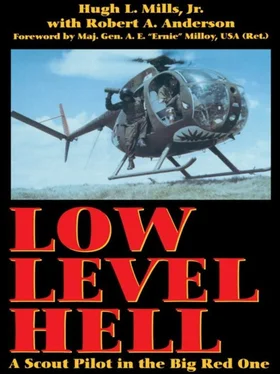Willis didn’t know what had exploded, but he could see that the explosion had obviously detonated in the top of a tree. The tree had nearly disintegrated, in addition to nearly blowing his aircraft out of the sky.
Though wincing with pain, Cook immediately began to throw M-60 fire into the enemy base camp area. A barrage of enemy weapons burst forth in response.
One Seven increased his speed and his radius of attack, and simultaneously broadcast a request to his Cobra that the ARPs be inserted to find out just what they had stumbled upon.
Major Moore was in the ops bunker at Phu Loi when the request came to scramble the ARPs. He quickly consulted his maps and surmised that the enemy outfit probably would try to make it back up into the Michelin and, ultimately, on into their sanctuary in the Razorbacks. With that thought, Six told One Seven to scout out an LZ to the north of his contact; then, if the enemy tried to make a run for it out the back door, the ARPs would be in position to block their escape.
Within thirty minutes, the ARPs were on the scene, led by the new Four Six, 1st Lt. Stuart J. Harrell, replacing Lieutenant Casey, who was badly wounded in the Huey-mine incident. As ordered, Willis had picked an LZ north of where he had been rocked by the tree explosion.
Once the ARPs were down, One Seven established FM contact with the platoon’s RTO and set about the task of steering Harrell’s infantrymen through the dense jungle toward the enemy base area. Leading their ground movement was the point man, Pfc. William J. Brown. To work point, a man needed a lot of experience and almost a sixth sense to detect impending danger. Unfortunately, Private First Class Brown had very little of either. He had recently arrived in country and had just been transferred into the ARP platoon as a casualty replacement.
Willis shepherded the ARPs closer and closer to the enemy bunker complex. As he did, point man Brown became more and more cautious. Quietly, warily, Brown approached the first bunker.
When he was just a few feet away, Brown prudently moved off to the side and took up a position of cover to study the potential firing lanes of the enemy emplacement. As he crouched for a brief moment to observe his front, a single SKS carbine shot suddenly cracked out of the heavy undergrowth to Brown’s flank. The ARP point man crumpled forward onto his face, dead before he hit the ground. The carefully aimed round was fired from another bunker to his left—one he hadn’t seen.
The whole jungle area immediately erupted into a thunderous hail of gunfire, as the entire enemy camp opened up with its full complement of machine guns, rifles, frag grenades in layers, and RPG rounds, which seemed to be going off in the trees and everywhere else around the surprised ARP platoon.
In that initial enemy fusillade, six more ARPs went down, including the platoon’s new Four Six. Both senior squad leaders, S. Sgt. Mark K. Mathewson and S. Sgt. James A. Jordon, were hit, Mathewson with a frag wound to the right leg and Jordon with a ripping gunshot wound to his left hand. Pfc. Sammy G. Lindsay crumpled to the ground with an enemy bullet piercing his left thigh. A CHICOM grenade went off right in front of Four Six, Stu Harrell, and the fragments shredded his left arm from shoulder to fingers. A Soviet RPG-7 round exploded right at the feet of Sgt. Allen H. Caldwell; he was dead before he hit the ground. Pfc. Robert L. Foster caught shell fragments in the thoracic area and was slammed down onto the blood-spattered jungle floor. The murderous barrage had, in just seconds, put one fourth of the ARP platoon out of action.
Flying right over the ARPs, Willis was enraged. But there was little he could do to help the aeroriflemen.
Aeroscout Bob Davis (One Three) had been sitting with his gun at Dau Tieng waiting to relieve One Seven on station. Davis and his Cobra immediately lifted off and arrived at the contact point in less than five minutes.
With One Three on the scene and briefed to provide cover over the beleaguered ARPs, One Seven beat it back to Phu Loi. Joe Cook, his left hand bleeding badly from Charlie’s grenade fragments, needed attention beyond the makeshift bandage he had bound around his fist.
I was leaning over the radios back at the ops bunker listening when the troop commander walked in. Davis’s gun, Bruce Foster, was yelling at One Three to get out of the way so he could shoot. Concerned that the ARPs were in over their heads, Six asked me to get cranked and fly up there.
I raced for my aircraft. Jim Parker met me there. Just back from his recuperation, he was scheduled as my Scramble 1 crew chief. Willis was also set to fly out with me. He had gotten Joe Cook to the medics, picked up another crew chief, and was ready to get back over the contact area.
As soon as we arrived at the scene, I dropped down low over the ARPs to get a firsthand report from S tu Harrell. I needed visual contact to assess what the enemy force was doing. Zeroing in on the area where Harrell was down with his RTO, I hit FM. “Four Six, this is One Six. What’s your sitrep?”
I could see him take the mike from his RTO. “We’re in bad shape, One Six. I’ve been hit either by a very well initiated L-shaped ambush or by a hell of a heavy and well dug in force.”
“What about your people?” I questioned.
Harrell’s bloody left arm lay limp at his side and, though his voice was sharp and clear, I could hear that he was in pain. “We’re completely covered. We’re taking very, very heavy fire… machine guns, rockets, grenades. I have at least two KIA, another five or six wou—”
His last words were smothered as the jungle below me opened up again with devastating fire—directed this time not only at Four Six’s position but also up at me as I flew just twenty to thirty feet off the ground.
Damn! I thought. We must have stepped on a lot of bad people down there. It must be at least a company plus—or, more likely, a battalion-minus-sized base area. But, whatever, it’s full of bad guys. They’re mad, and they sure as hell want to fight.
I pulled an armful of collective and moved away until the firing calmed down. But I knew I had to get back in there and find out from Four Six where his men were.
I hollered back at Harrell. “Get me a position report on your people. I can’t shoot until I know where all of your people are.”
I swooped back in again—this time faster—to see if I could get a better picture of Harrell’s situation. It was hot down there—like touching a light switch and having the lights come on. When I dropped down, the enemy fire came up. Instantly.
But this time, I got a better lay of the land. There was an old tank bust trail that ran from the southeast to the northwest, which roughly bisected what I could see of the enemy base area. Harrell’s ARPs had been inserted in an LZ to the west of the trail. They had started advancing directly east toward the base camp when point man Brown was hit, and all hell broke loose.
The enemy base camp most likely had.been alerted to impending trouble when the initial explosion had rocked Willis’s ship. Probably reacting to the fact that they had been discovered, Charlie decided to get out of his base area and escape north before the aeroscout brought more firepower down on them. When the ARPs were inserted and headed into the base area from the west, they cut the old tank bust, just as troop commander Moore had foreseen. The tactic had blocked the trail and posed an obstacle to the enemy, who wanted to use it to escape north, back to their established sanctuary in the Razorbacks. The enemy soldiers were obviously getting set to ram the ARP’s right flank from the south, bust through their ranks, then head on home up the trail.
With this scenario in mind, I dropped down again on a fast run-by. Looking closer this time, the only people I could see moving around the trail were Four Six and his RTO. I spotted several more of our people who were down and not moving. It didn’t look good.
Читать дальше












